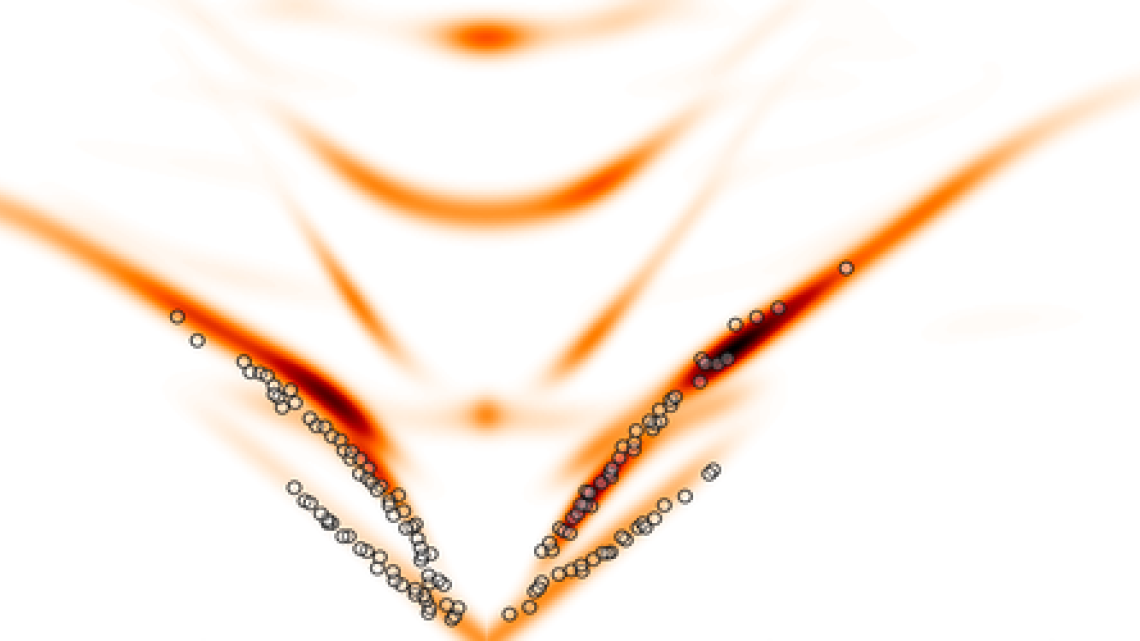
Color map showing predicted inelastic helium atom scattering signals from Nb(100). Photo Credit: M. Kelley et al.
News directly from Cornell's colleges and centers
Researchers develop new model to predict surface atom scattering
By Susan Newman
A group of Cornell-led researchers in the U.S. National Science Foundation-funded Center for Bright Beams have developed a new theoretical approach to calculate how atoms scatter from surfaces. The method, developed by recently conferred Cornell physics Ph.D. Michelle Kelley and her collaborators and published in Physical Review Letters, is the first method to explicitly calculate the interactions between a scattering atom with a surface directly from first principles.
To understand a material’s surface, you could use a beam of electrons or X-rays to probe the surface, but that would damage the material. For years, researchers have been probing crystalline material surfaces using the scattering of beams of molecules off of the surface. In particular, helium is well-suited to this task because it is able to provide atomic-scale resolution at low energies. However, the models that researchers have used to understand material properties this way are flawed.
When helium scatters off of a surface, it scatters off the material’s free-electron density rather than penetrating the surface of the material leaving behind no damage while still exciting useful vibrations in the surface. This makes helium beams potentially very useful for understanding the surface characteristics of materials on the molecular level.
“As opposed to scattering electrons or x rays, atomic and molecular beams are nondestructive surface probes that allow for investigations of increasingly sensitive and delicate samples, pushing the scientific limits of surface types that can be feasibly examined,” said Kelley.
However, in order for atom scattering to be useful, accurate theoretical predictions of scattering signatures are key. To date, these predictive models have been oversimplified or misleading. Kelley and her group have put forth a new method of prediction scattering that provides a fully ab initio, or from the start, approach to guiding non-destructive atomic beam scattering such as helium-atom scattering.
“We can now, for the first time, compute theoretically, without any outside inputs or assumptions, how helium atoms deposit energy into a material when they bounce off of its surface,” said Tomás Arias, professor of physics in the College of Arts and Sciences (A&S), who directed and supervised the research.
Kelley’s group used the surface interactions of a helium beam with a niobium surface to capture how atom scattering and phonon excitation interacted with each other. This allowed them to create this new predictive theory that will change the way researchers model surface structure. Although the theory was developed using a helium beam and niobium, it can be generally applied to other atom-surface combinations.
“Our new theoretical approach produces results of high accuracy as it completely avoids unreliable models and the associated tuning of parameters that were required in previous semi-empirical approaches,” Kelley said. “Improving the accuracy of theoretical predictions of this kind will help guide and interpret next-generation experiments that use atomic beam scattering as a nondestructive probe of sensitive surface properties.”
“This result will help to improve our understanding of how electrons and atoms in a material interact,” Arias said, “ shedding light on important phenomena including superconductivity by guiding such experiments and improving their interpretation.”
Kelley and Arias are part of the Center for Bright Beams (CBB) – a National Science Foundation Science and Technology Center funded under award PHY-1549132.
Media Contact
Get Cornell news delivered right to your inbox.
Subscribe